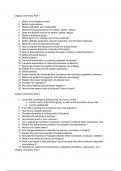Organic Chemistry Part 1
1. Define a homologous series
2. Define hydrocarbons
3. Explain saturated and unsaturated
4. Name the functional groups for alkane, alkene, alkyne
5. State the general formula for alkane, alkene, alkyne
6. Define a functional group
7. Which part is the ‘reactive’ part of the molecule?
8. Define aliphatic molecules, alicyclic molecules, and aromatic molecules
9. Name the ways to represent formulae
10. How to express the structural formula of a double-bond?
11. How to express branches in structural formulae?
12. How to show branches in skeletal formulae? (methyl vs ethyl branches?)
13. Define structural isomers
14. Define alkanes
15. Trends/characteristics of physical properties of alkanes?
16. Trends/characteristics of chemical properties of alkanes?
17. Name and explain the reactions that alkanes can undergo
18. Explain the process of free-radical substitution
19. Define alkenes
20. Explain trends and characteristics of physical and chemical properties of alkenes
21. Name and explain the reactions that alkenes can undergo
22. Explain what uses halogenation of alkenes have
23. Condition for hydration?
24. How does addition polymerisation happen?
25. How to draw repeat units of polymers? How to name?
Organic Chemistry Part 2
1. List all the homologous serieses that you need to know
a. List the name of functional group, as well as the functional group itself
b. List the prefix/suffix
2. If an -OH is attached to a benzene ring, what happens?
3. How do you classify alcohols?
4. Describe the trends in boiling points of alcohols
5. Describe the solubility of alcohols
6. Are alcohols good or poor solvents?
7. List + explain the reactions of alcohols, and their conditions (their mechanism, etc)
8. What is the experimental condition for oxidation and esterification?
9. How do you name esters?
10. Can halogenoalkanes be classified as primary, secondary or tertiary?
11. Explain the physical properties of halogenoalkanes
12. Describe the reactions of halogenoalkanes (their mechanism, products, condition)
13. What is the molecular formula of benzene?
14. What was Kekule’s initial prediction about benzene, and what evidence supported/
contradicted it?
15. Describe the reaction(s) that benzene undergoes (conditions, mechanism, etc)
Organic Chemistry Part 1
, 26. Define a homologous series
a. A series of compounds of the same family, with the same general formula,
which differ from each other by a common structural unit, e.g. CH2
27. Define hydrocarbons
a. A compound containing only hydrogen and carbon atoms
28. Explain saturated and unsaturated
a. Saturated:containing single C-C bonds only vs Unsaturated: compounds
contain double or triple carbon bonds
29. Name the functional groups for alkane, alkene, alkyne
a. Alkane: Alkyl
b. Alkene: Alkenyl
c. Alkyne: Alkynyl
30. State the general formula for alkane, alkene, alkyne
a. Alkane: CnH2n+2
b. Alkene: CnH2n
c. Alkyne: CnH2n-2
31. Define a functional group
a. Group of atoms responsible for the characteristics of a compound (reactive
part of a compound)
32. Which part is the ‘reactive’ part of the molecule?
a. Functional group
33. Define aliphatic molecules, alicyclic molecules, and aromatic molecules
a. Aliphatic: compounds with carbon and hydrogen atoms joined in straight or
branched chains
b. Alicyclic: Compounds arranged in non-aromatic rings
c. Aromatic: Compounds containing a benzene ring; aromatic, unsaturated
hydrocarbon
34. Name the ways to represent formulae
a. Structural, molecular, skeletal, empirical
i. Condensed structural formula: CH3CH2CH2CH3 (instead of displaying
the bond)
35. How to express the structural formula of a double-bond?
a. 2 lines
36. How to express branches in structural formulae?
a. Brackets
37. How to show branches in skeletal formulae? (methyl vs ethyl branches?)
a. Add one line for methyl, for ethyl add 2 lines (bent)
38. Define structural isomers
a. Compounds with the same molecular formula but different arrangement of
atoms/different structural formulae
39. Define alkanes
a. Saturated (only single C-C bonds) hydrocarbons w the general formula
CnH2n+2
40. Trends/characteristics of physical properties of alkanes?
a. Insoluble in water or aqueous solutions (because alkanes = non-polar, as C-H
bond’s polarity is negligible -> alkanes therefore cannot form bonds with H2O;
but are soluble in organic solvents)
b. Low melting point and boiling point (BP increases with chain length, because
longer chains = more C = more electrons + more contact area between
molecule -> stronger London forces




